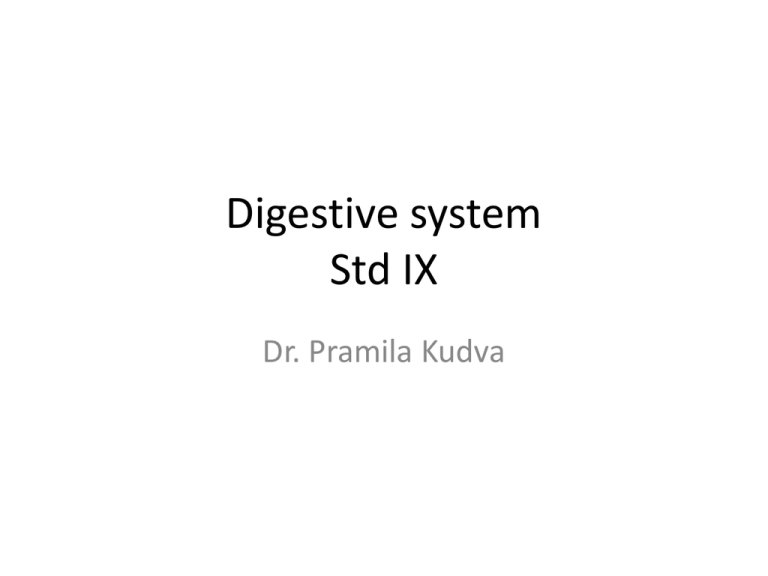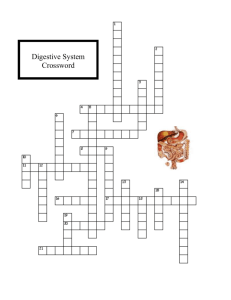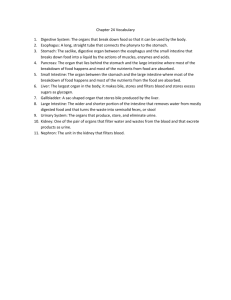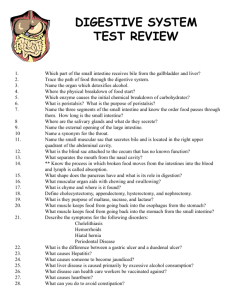File
advertisement

Digestive system Std IX Dr. Pramila Kudva Phases of Digestion • • • • • Ingestion Movement Digestion Absorption Egestion 1. Parotid 2. Sub-mandibular 3. Sub-lingual Ptyalin [Salivary Amylase] Starch Maltose Enzymes They are proteins Act on Specific product and the end product is also specific Speeds up the rate of chemical reaction Can be used repeatedly Acts best at a particular temperature Acts best at a particular acidity or alkalinity Mechanism of Swallowing • Swallowing is a coordinated activity of the tongue, soft palate, pharynx and esophagus. • Phases – Food is pushed into the pharynx [throat] by the tongue. (voluntary) – Tongue blocks the mouth – Soft palate closes off the nose – Larynx (Adam’s Apple) rises so the Epiglottis (a flap of tissue) can close the opening of the trachea. Peristalsis Stomach Rugae Stomach • J-shaped muscular sac • Has inner folds (rugae) that increases the surface area of the stomach. • Churns and grinds together the bolus into smaller pieces. • Food is mixed with gastric juices (hydrochloric acid and enzymes) secreted by the stomach walls. • HCL helps break down food and kills bacteria that came along with the food. Stomach • Pepsin – major enzyme; converts proteins into peptides in the presence of HCL. • Renin – acts on Milk proteins • Mucus – lubricates food and protects the gastric lining from strong digestive juices. • Converts the bolus into a liquid (chyme) after 4 hrs of mechanical and chemical digestion • Chyme passes through the pyloric sphincter into the small intestine. Gastric juice contains water, Salts, HCl and Pepsin Function of Acid – Kill germs, activates Pepsin HCl Pepsinogen Inactive Pepsin Active Pepsin Proteins Enzyme Prorennin Inactive Casein Soluble HCl Peptides Renin Active Renin Enzyme Paracasein A Peptide Insoluble Calcium Paracaseinate Soluble Acted upon by Pepsin Small Intestine • Site of greatest amount of digestion and absorption Small Intestine • Long (20 ft), coiled tube beneath the stomach. • Has three parts: • Duodenum – upper part; about 10 in; connected to the stomach where the digestive juices from the pancreas and the liver combine with chyme making it thin and watery. • Jejunum – about 8 ft • Ileum – about 12 ft Liver – Largest gland of the body – Stores vitamins A,D,E,K – Stores sugar and glycogen – Produces bile (watery, greenish substance) which goes through hepatic duct and cystic duct join to form the bile duct. – Bile may directly go to the duodenum or may get stored in the gall bladder. – Colour of the bile is due to biliverdin or bilirubin – formed by the breakdwn of dead or worn out RBCs. •Bile contains lot of sodium bicarbonate which neutralises the acid content •Bile is an emulsifier NOT an enzyme. •Emulsifier – dissolves fat into the watery contents of the intestine. Fat Bile Acidic chyme Emulsion / Emulsified Fat Bile NaHCO3 Alkaline Chyme Pancreas – Produces a juice that contains enzymes (amylase and insulin) to break down carbohydrates, fats and protein. – Secretes the juice into the duodenum through the pancreatic duct. Trypsinogen Enterokinase Inactive Proteins & Peptides Trypsin Trypsin Active Smaller Peptides + Amino Acids Left over Amylopsin Maltose Starch Pancreatic amylase Emulsified Fat Steapsin Fatty acids + Glycerol Small Intestine • Has folded inner walls covered with fingerlike projections (villi; sing. – villus) • Each villus has tinier projections called microvilli that absorbs digested food. • Villi and microvilli increases the surface area of the small intestine for greater absorption. • Each villus is covered by single cell thick epithelium • Inside the villus are an artery, A vein, Blood capillaries and a lymph vessel called Lacteal. Small Intestine • Takes about 4 – 8 hrs to complete its journey. • Mucosa (inner wall) – secretes several enzymes that acts on the food. • The Bile and pancreatic enzymes act on the food • Digested nutrients are absorbed through intestinal walls. Intestinal juice converts the remaining peptides into amino acids, complex carbohydrates into simple sugars. Action of Intestinal Juice Erepsin / Peptidase Peptides Amino acids Maltase Maltose Glucose Sucrase Sucrose Glucose + Fructose Lactase Lactose Emulsified Fat Glucose + Galactose Lipase Fatty acids + Glycerol Large Intestine Large Intestine • Caecum, Colon and rectum • Colon - larger diameter, but shorter (5 ft) • Water is absorbed from the undigested food making the waste harder until it becomes solid. • Waste stays for 10 – 12 hours. Large Intestine • Waste is pushed into the expanded portion (rectum) of the large intestine. • Solid waste stays in the rectum until it is excreted through the anus as faeces. Defecation • Faeces consists of 75% water, 20% solid matter - dead bacteria, undigested fat & proteins and roughage Assimilation of Food Carbohydrates & amino acids Blood stream surrounding the small intestine Hepatic Portal Vein Liver Fatty acids & glycerol Intestinal Villi & lymphatic system Fats used in the synthesis of compunds in the body cells Excess is deposited as subcutaneous fat or around certain visceral organs







